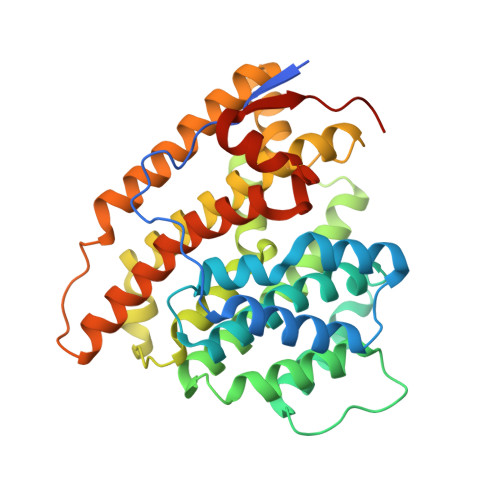Structural Insights into Three Sesquiterpene Synthases for the Biosynthesis of Tricyclic Sesquiterpenes and Chemical Space Expansion by Structure-Based Mutagenesis.
Lou, T., Li, A., Xu, H., Pan, J., Xing, B., Wu, R., Dickschat, J.S., Yang, D., Ma, M.(2023) J Am Chem Soc
- PubMed: 37018048
- DOI: https://doi.org/10.1021/jacs.3c00278
- Primary Citation of Related Structures:
8H4P, 8H6Q, 8H6U, 8H72 - PubMed Abstract:
The cyclization of farnesyl diphosphate (FPP) into highly strained polycyclic sesquiterpenes is challenging. We here determined the crystal structures of three sesquiterpene synthases (STSs, namely, BcBOT2, DbPROS, and CLM1) catalyzing the biosynthesis of the tricyclic sesquiterpenes presilphiperfolan-8β-ol ( 1 ), Δ 6 -protoilludene ( 2 ), and longiborneol ( 3 ). All three STS structures contain a substrate mimic, the benzyltriethylammonium cation (BTAC), in their active sites, providing ideal templates for quantum mechanics/molecular mechanics (QM/MM) analyses toward their catalytic mechanisms. The QM/MM-based molecular dynamics (MD) simulations revealed the cascade reactions toward the enzyme products, and different key active site residues that play important roles in stabilizing reactive carbocation intermediates along the three pathways. Site-directed mutagenesis experiments confirmed the roles of these key residues and concomitantly resulted in 17 shunt products ( 4 - 20 ). Isotopic labeling experiments addressed the key hydride and methyl migrations toward the main and several shunt products. These combined methods provided deep insights into the catalytic mechanisms of the three STSs and demonstrated how the chemical space of STSs can rationally be expanded, which may facilitate applications in synthetic biology approaches toward pharmaceutical and perfumery agents.
Organizational Affiliation:
State Key Laboratory of Natural and Biomimetic Drugs, School of Pharmaceutical Sciences, Peking University, 38 Xueyuan Road, Haidian District, Beijing 100191, China.
















